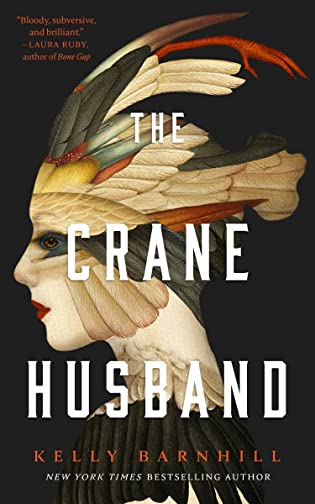 The Crane Husband by Kelly Barnhill
The Crane Husband by Kelly Barnhill Format: eARC
Source: supplied by publisher via Edelweiss
Formats available: hardcover, ebook
Genres: fantasy, horror, magical realism, retellings
Pages: 128
Published by Tordotcom on February 28, 2023
Purchasing Info: Author's Website, Publisher's Website, Amazon, Barnes & Noble, Kobo, Bookshop.org, Better World Books
Goodreads
Award-winning author Kelly Barnhill brings her singular talents to The Crane Husband, a raw, powerful story of love, sacrifice, and family.
“Mothers fly away like migrating birds. This is why farmers have daughters.”
A fifteen-year-old teenager is the backbone of her small Midwestern family, budgeting the household finances and raising her younger brother while her mom, a talented artist, weaves beautiful tapestries. For six years, it’s been just the three of them—her mom has brought home guests at times, but none have ever stayed.
Yet when her mom brings home a six-foot tall crane with a menacing air, the girl is powerless to prevent her mom letting the intruder into her heart, and her children’s lives. Utterly enchanted and numb to his sharp edges, her mom abandons the world around her to weave the masterpiece the crane demands.
In this stunning contemporary retelling of “The Crane Wife” by the Newbery Medal-winning author of The Girl Who Drank the Moon, one fiercely pragmatic teen forced to grow up faster than was fair will do whatever it takes to protect her family—and change the story.
My Review:
There is a group of tales in Japanese folklore about a crane who returns a favor to a man. The best known of those tales is The Crane Wife. This story isn’t exactly that one for any number of reasons, quite possibly the least of which is that in this case it’s the husband who is the crane. The question of whether this crane husband is or is not returning anything remotely like a favor to the woman who makes herself his wife is open to one hell of a lot of questions.
Questions that her teenage daughter is left behind to answer – after her mother flies away.
The story in The Crane Husband perches almost gracefully at the sharp, pointy end of the pyramid between magical realism, fantasy and horror. Alternatively, it’s just plain horror about a teenager coping with too many adult issues by processing them through mythmaking.
Or both.
On the surface, it’s the story told by a nameless teenage girl as she watches her mother become enraptured by a crane who turns into a man in the dark of night. Her mother, an artist who has always seemed to be barely in touch with the real world, gives her every waking attention and her every thought and care to her crane husband. She turns so deeply inward as well as orients so totally on the shapeshifting crane that she stops doing any of the tasks necessary to keep their tiny household barely afloat.
Her daughter does her best, just as she has been doing since her father died, to manage the sales of her mother’s stockpiled art – of which there is little – as well as managing the food and the finances in general just to keep the lights on and to keep both herself and her little brother fed and clothed and sent to school.
Even as she watches her mother self-destruct. Until the girl finally comes to the pragmatic and necessary conclusion that her mother can’t be helped and that she herself is probably too damaged to save but that her adorable, winsome, six-year-old brother still has a chance.
If she acts before it is too late for them all. Unless it already is.
Escape Rating B+: The story on the surface may or may not be the real story, and that’s the part that keeps the reader guessing – or at least kept this reader guessing – even after the last page was turned.
It could be myth coming to life, meaning that the surface story is the true story. That her mother gave herself over to the crane in the hopes of finding a magical escape from the farm and the children that she should have taken long ago. And can’t resist now that she has found another way.
Very much on my other hand, this is also a story about a teenage girl keeping her family together in the face of her only remaining parent’s criminal neglect. While she is stuck watching her mother’s abuse at the hands of a charismatic and dangerous man who will certainly turn to her once he tears and beats her mother into an early grave.
That the girl turns to the language of myth to tell the story to herself as a coping mechanism would be as reasonable a solution as anything can be in the situation she’s enduring. Especially as the version we’re reading is the version she’s telling herself twenty years after her mother left. Or died.
Or turned into a crane and flew away.
Whether her story is an exercise in rationalization, a tale of outright horror or something in the middle haunts the reader as the tale draws to its conclusion. Along with the now adult girl’s still plaintive search for the brother she failed to save after all.














